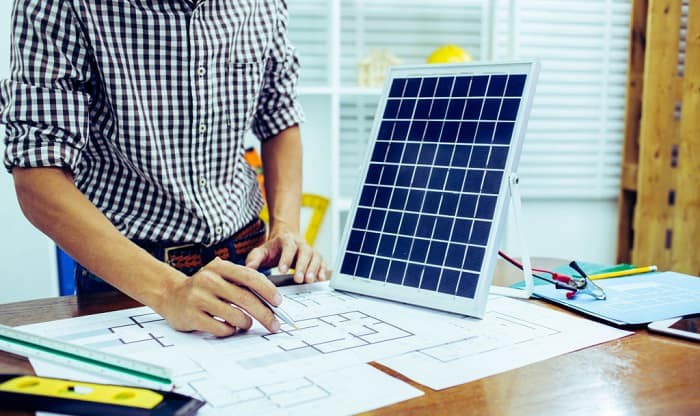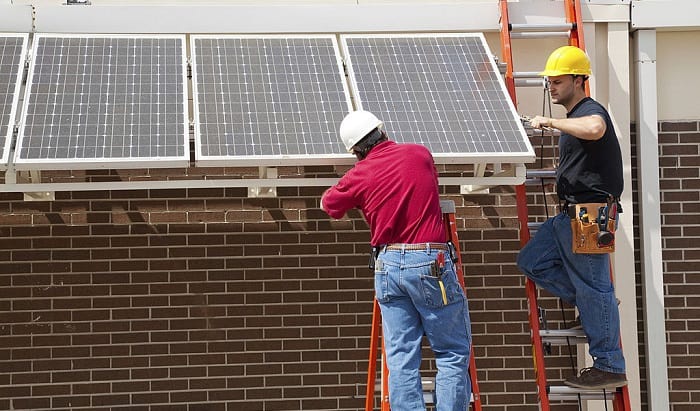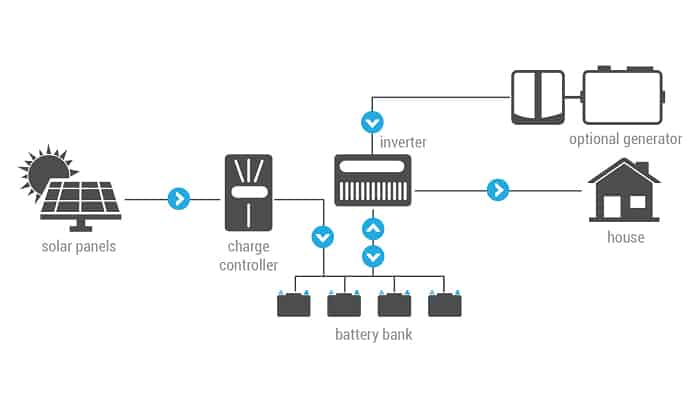An off-grid solar system allows users to satisfy all their energy requirements using the sun’s power without an electrical grid. Essentially, to make this possible, you must set up a solar power system linked with an energy storage system, such as a solar-powered battery.
Are you wondering how to build an off grid solar system for your home? In this guide, we’ll help you learn more about an off-grid solar system before buying one. Likewise, we’ll help you determine the materials and steps needed to get started in your solar energy journey.
These are the steps, which are described in detail below: devise a system according to your requirements, select the installation spot, order components, construct the battery housing, assemble the panels, and wire everything.
Table of Contents
- What Is an Off-grid Solar System
- What Are the Materials You Need to Prepare for Diy Off Grid Solar Systems
- How to Get Started With Your Off Grid Solar Design
- Step 1: Devise a DIY solar system that satisfies your requirements.
- Step 2: Select the appropriate spot for your solar panels.
- Step 3: Order the suitable components for your solar system.
- Step 4: Construct your solar battery compartment or housing.
- Step 5: Assemble the solar panels.
- Step 6: Wire up your off-grid solar system.
- Who Will Benefit More From Installing Off-grid Solar Systems
- The Bottom Line
What Is an Off-grid Solar System
In its most basic definition, an off-grid solar system is not connected to the grid. It is similar to a large battery bank attached to massive power generators. In other words, it is a system of distribution and transmission lines.
Fundamentally, the grid is critical to obtain a consistent power supply. As you might already know, solar energy is a periodic energy source that is at its peak on bright sunny days and is minimal on overcast days.
The grid-connected solar system eliminates the unpredictability of power production and provides users with a sleek user experience of consuming electricity.
Meanwhile, off-grid power solutions are unquestionably ideal to utilize in locations where grid connectivity is geographically impossible. The off-grid system is considered the ideal means of acquiring an energy source in high-altitude locations and areas located quite far from the grid.
What Are the Materials You Need to Prepare for Diy Off Grid Solar Systems
Here are the components you need to prepare when getting started with your off grid solar setup:
- Charge Controller: This item safeguards the battery bank from overcharging. It controls how much current should be injected into your batteries to ensure maximum performance.
- Photovoltaic Panel: You utilize the solar panel to transform solar power into electrical power. Whenever solar panels are exposed to direct sunlight, they produce electricity that feeds your batteries.
- AC Load Center (optional): This one is similar to a panel board that comes with all the suitable fuses, switches, and circuit breakers that aid in sustaining the necessary AC voltage. It also helps sustain the required current to the corresponding loads.
- DC Load Center (optional): This is similar to the AC load center in terms of circuit breakers, fuses, and switches. It sustains the necessary DC voltage and maintains the required current to the corresponding loads.
- Battery Bank: Since there would be times without or with little sunlight, a battery bank is required to store excess electricity for these conditions. Unfortunately, this component is the one that makes an off-grid solar system pretty costly.
- Connected Load: This one ensures that your electrical circuit is complete and that the electricity could smoothly flow through.
- Solar Inverter: Also known as a power electronics device, you use this tool to transform DC to AC. The energy produced by solar systems is DC in nature; on the other hand, almost all our household loads call for AC power.
- Transfer Switch (optional): When you install a backup generator, you’ll need to install a transfer switch. It assists you in shifting between two power sources (for example, your solar power and your generator that runs on diesel). It could be manual or automatic.
- Backup Generator (optional): This tool isn’t often required, but this is an excellent device to add to your solar system since it boosts dependability. With it, you can ensure that you’re not merely reliant on solar energy for your energy needs.
How to Get Started With Your Off Grid Solar Design
To get started on building your simple off-grid system, you must check out the following:
Step 1: Devise a DIY solar system that satisfies your requirements.
First and foremost, you must be well aware of how much energy you require and how your energy consumption changes throughout the day and year. Understanding the daily and yearly pattern of your family’s energy consumption is substantial in outlining an efficient solar system.
Step 2: Select the appropriate spot for your solar panels.
Picking the appropriate location to inhibit excessive shading and ensure passive cooling and proper access for your solar panel can intensify the efficiency of your panels over their lifespan. Solar panels specially designed for low light conditions will be suitable for this case.
Step 3: Order the suitable components for your solar system.
The moment you have selected the placement of your panels, you’ll obtain an idea of the power potential of your location. Hence, you can select and order the right components for your solar system.
You have lots of choices to consider, such as:
- The size and type of your charge controller (PWM or MPPT)
- The size and number of your solar cells
- The battery type and the capacity of the battery bank
- The overall voltage of each leg and which loads should be DC or AC
- Inverter rating, if any
Step 4: Construct your solar battery compartment or housing.
The next thing you’ll need to prepare when you have the components ordered is the battery house. It could be a space in your current home, a separate shed, or a part of the garage.
You must ensure that the room where the battery is housed is safe from anything or anyone that could damage the battery. This could also avoid discharging the acids inside.
Please remember that most batteries don’t do well with frigid weather, so they require some amount of temperature control.
If you opt for cheaper unsealed batteries, you’ll need to ensure proper ventilation in your battery compartment to impede the accumulation of hazardous hydrogen gas. This is because such types of batteries discharge the explosive hydrogen gas in minimal amounts when charging.
Most solar system installations have the primary power electronics, including inverter/s, charge controller/s, and safety fuses, shutoffs, and breakers in the battery compartment to minimize the costs.
Step 5: Assemble the solar panels.
The next step is building the solar panel support and setting up the solar array. Please note that solar panels are way more efficient when they face the sun directly, and they last longer when they’re well cooled and rigid. Choose quality solar panels here.
A solar support framework can be established in several methods, depending on the materials you have, and of course, your skill level. Establishing a south-facing A-frame framework using metal or wood is the best.
It’s also beneficial if you can manually adjust the tilt of your solar panels during winter and summer. This way, you could bolster your power output by up to 40 percent with nearly no extra cost. Alternatively, you could make your DIY one-axis or two-axis tracking system.
Step 6: Wire up your off-grid solar system.
Now that your panels are settled, the next thing you’ll need to deal with is the wiring of your solar system. The good news is that this process does not necessarily have to be complicated. Going off-grid means that your electrical system can be much less intricate than the grid-tie type of solar system.
When you go off-grid, you can decide if you prefer to set up an all-DC system, which could be pretty straightforward and efficient. An AC system is also possible.
Would you like to explore a simple solar power system for an off-grid cabin? If yes, you might want to watch this exciting and easy-to-follow video tutorial:
https://www.youtube.com/watch?v=xal5xzC0MOc
Who Will Benefit More From Installing Off-grid Solar Systems
Installing off-grid solar systems is commonly the first thing consumers think about when they plan to go solar. Even so, it is not ideal for all consumers. It’s worth noting that solar system designing or installation is primarily an excellent option for people residing in remote locations.
In particular, off-grid solar systems are great for people who do not have affordable and dependable access to the grid. Further, it benefits those who prefer to live a self-sufficient lifestyle without worrying about paying steep utility bills monthly.
Chiefly, an off-grid solar system is also ideal if you’d like to have the ability to access instant power during a power outage.
The Bottom Line
By and large, off-grid solar systems use batteries to keep the energy generated from solar panels. Since you’ll be banking purely on your own solar setup to cover all your energy requirements, your system must be designed and sized to suit diverse needs throughout the year. This is particularly essential during winter, where there are short sunlight hours.
Hence, we highly suggest that you carefully read all the distinct components, the process of planning and sizing your solar system so it can be efficient for many years to come. Did you find this “how to build an off grid solar system” article informative? Please feel free to share it with other solar energy advocates out there!

I am Kathleen Miller, staff writer and reviewer of the Avasolar team. Working with the team has been a pleasure for me so far, I hope to bring readers useful information by creating detailed and easy-to-follow contents.



